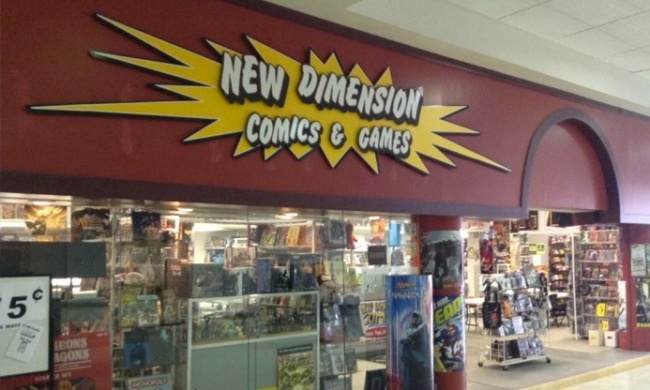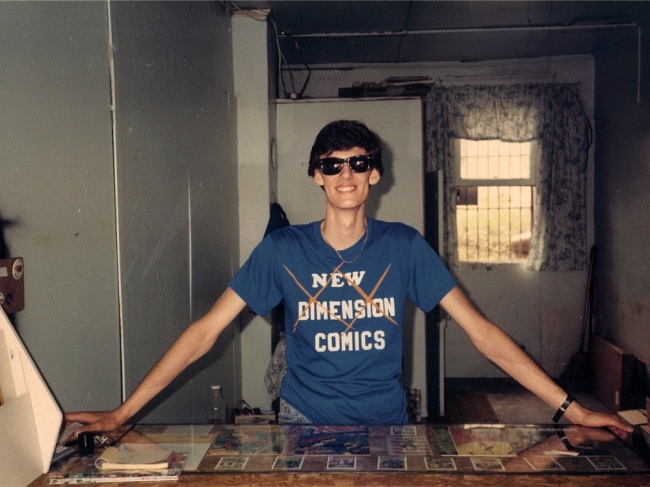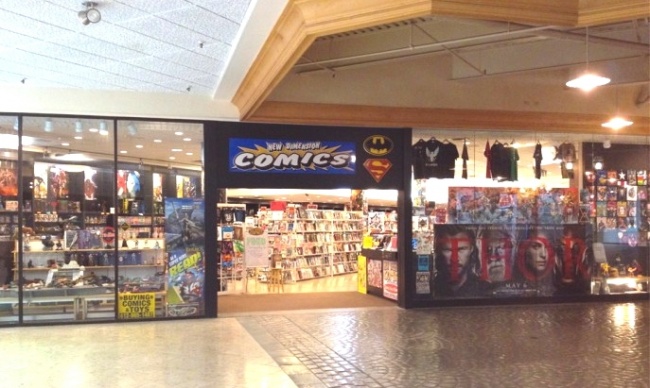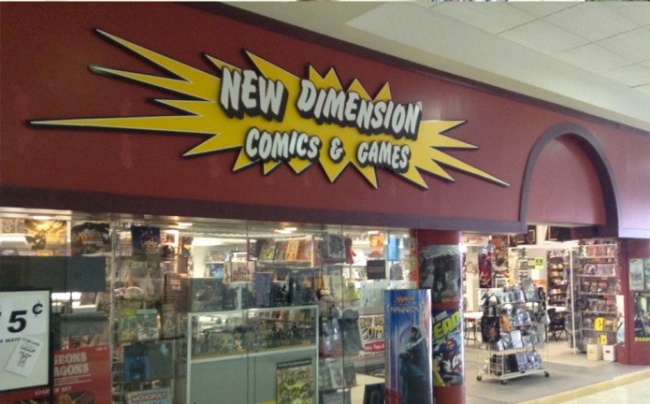In Business 3x3, a business retailer or executive will share their experience with three things they’ve done right, three things they’ve done wrong, and what else they’ve learned along the way.
Todd McDevitt got what might be called an “early start” as an entrepreneur. He opened his first comic store between his junior and senior years in high school.
A comic-loving friend passed a copy of Alpha Flight #4 along to McDevitt back in 1983. McDevitt figured he could get in on the ground floor as a reader with such a low number, and quickly, things changed.
“I discovered the business end of it,” McDevitt says. “If I bought a few issues through the mail, I could get a discount, and sell a few issues off to friends.”
In 1986, McDevitt opened a store just for the summer, and by the time he went to college, he had a full-blown year-round operation, with his brother running the shop during the week while Todd was in class. And 30 years later, New Dimension Comics is a juggernaut in the Pittsburgh, PA area with six stores.Along the way, McDevitt has had a ton of fun, and learned a lot about business.
THE GOOD
Buy Your Property
Six stores are a lot. But McDevitt likes to own the real estate he sits on.
“So many people are scared to buy, for some very good reasons,” he says. “But if you’re committed to your business, it should be long term. By buying property, you’re making your money work for you, you build equity, and all those classic reasons are true.”
McDevitt admits there are headaches.
“When you have a leaky roof, you have to pay to fix it,” he says. “But part of the entrepreneurial spirit is taking all the credit and getting all the blame. You control your destiny. You fix that roof the way you want, on your time, and you negotiate the price.”
All in all, McDevitt is a huge believer in the real estate game. “I continue to do it. I just bought a warehouse property knowing that I’m building for the future,” he says. “I buy in such crazy quantity that I need a loading dock.”
Diversify How You Sell
Why is the warehouse and the loading dock so important? Because McDevitt buys in huge quantity, and finds a way to get multiple bites off the apple.
“I find a way to make every buy work,” he says. “I say every buy is a pie that I can carve up 30 different ways to make money.”
Look no further than the most recent crazes du jour. “A buddy of mine who’s in the zombie business told me he needs zombie comics,” McDevitt says. “So I can sort for that, and now when I get a zombie comic, there’s a box for that. Fill the box, pack it up, and that’s another slice of my pie.”
And everything old becomes new again. Or at least newly saleable again.
“There are hidden gems,” McDevitt adds. “Marvel Two-in-One #61 is suddenly a $40 comic because of the first appearance of a character who might be in a movie, and I know I have those I’m processing in buys of collections I’ve made.”
McDevitt makes money, and has fun.
“I’m like the god of a buy,” he laughs. “I can decide the destiny of all these comics and where they wind up. I swear, there are 30 different ways I can carve up a comic book collection, and by the time I’m done, 100,000 books isn’t that many books.”
Love Your Back Issues…
The new and “bookstore” model has been the recent arc of where many comic stores are going. But McDevitt keeps one foot firmly in the past.
“I’ve always focused on back issues,” he says. “I know a lot of stores have decided they’re not worth the real estate, but I feel they’re part of the identifying characteristic of a comic store. I think if you take them out, you’re taking away part of the soul of the comic store.”
McDevitt has the space. His three biggest stores clock in at 12,000-15,000 square feet each.“I feel like I need a full run of…almost everything!,” he exclaims. “If someone strolls in and says, ‘I used to collect Ninja High School back when I was a kid,’ and they want to re-buy their childhood, we can say, ‘Great. Here’s issues #1-#17.’ And they go away happy.”
And McDevitt took the time to crunch the numbers.
“I started to think I spend way too much time on this, and my staff was giving me the same concern,” he says. “So I took a very pointed financial look at it to see if it was justified. And when I did the math on the man-hours, the material, the cost of the buys and all…it yielded a number that said I should have been buying more comic books. It was legitimately, financially viable.”
THE BAD
…But Don’t Love Your Back Issues Too Much
The back issue business is fun and profitable for McDevitt. But it’s not the be-all, end-all.
“There have been some financial pitfalls along the way, so maybe I need to spend more time looking at the financial side of things rather than burying myself in longboxes,” he admits. “When I’m forced to do numbers, I kind of enjoy it as well, but if I had my way… I’d be sorting through comic books. And that may have hurt me on one or two occasions where there were some significant debts I got into.”
Luckily, McDevitt has weathered all storms.
“Being in business means you have to be in business, and I paid everything off, but I really learned I have to take care of that stuff so that I have the time and the luxury to play with comic books,” he says.
Hire Right
“You need to hire the right people to do this kind of work,” McDevitt says. “Most people do this kind of work to be in it, you know, rather than the giant paycheck at the end. But you have to be aware that people have families to feed, and I take great pride when someone wants to make this their career job.”McDevitt thinks both competence and attitude are important.
“I had one guy who was really good at the job, but he always had his hand out,” McDevitt says. “I understood it, and I did everything I could to satisfy him, but after a while it became clear to me that the paycheck was all that was on his mind; not the job. So… he’s not working here any more.”
And McDevitt learned to look for the hidden gems not just in his longboxes, but also on his staff.
“One guy many years ago told me, ‘Hey, I could make a couple more bucks an hour at the mall selling pretzels.’ I asked him if that was his way of putting in his notice and he said, no, he’s way happier working in a comic store, maybe taking less to be part of this team, this community, and this process,” McDevitt relayed. “Those guys who really embrace it, well, those are the ones maybe you give a step up, a raise.”
Embrace Online
For someone with a lot of books to sell, McDevitt is missing one giant sales tool.
“I didn’t embrace internet sales early enough,” he laments. “I always had my focus on my stores, and I don’t regret that part, but if I had to do it all over again, maybe I should have done a better job there.”
McDevitt sees the online effect even in person.
“At conventions, if someone is on the fence about an expensive book, they might say, ‘Oh, well, you have a website, right? I’ll check it out there, and maybe I’ll buy.’ And I’ll have to tell them I have a website, but this stuff isn’t for sale on it. Their natural assumption is, yeah, that my stuff is available on a website as well.”
McDevitt has AlwaysBuyingComics.com for, duh, buying. And he’s looking to ramp up his internet sales as well for both reasons of business, and social embarrassment.
“I’ll meet somebody at a bar and tell them what I do, and one of the first things out of their mouth is, ‘I bet you sell a lot of stuff online,’” McDevitt laughs. “Well…not so much! It’s 3-5% of my business on a good day, and that’s pretty much just eBay where we dabble.”
AND WHAT ELSE?
“I remember in my first two stores thinking, ‘Man, this is how much rent?’ Now I’m paying three to five times that for some of the locations I do not own. So…yeah, obviously, buy real estate where you can.”
“I’m addicted to buys. Some people are addicted to ‘normal’ shopping, shopping for shoes, shopping for clothes or whatnot. But not me. I get an adrenaline rush when I find this cool comic stuff, and just like any addict, the more expensive it is…I escalate along with it.”
“We write down everything we sell in back issues every week, and that list goes down to the warehouse. So we can dive into what was sold, and look to replenish. We have six stores, so I’m comfortable with a lot of back issue inventory.”
“I joke that I could have a million stores, I just need the right people to man them. You need good fits, people who like to be part of the community, the hobby, the whole thing. I think every business struggles to get the right people. You see ‘help wanted’ signs everywhere. It’s easy to find people, but it’s hard to find the right people.”
“I tell my employees, ‘You better spend 15 minutes a day walking the store like you’re a customer.’ You see old fliers? Take ’em down. Items don’t have price tags? Price them. Anything you think might confuse a first-time mom or dad walking in? Fix it.”







